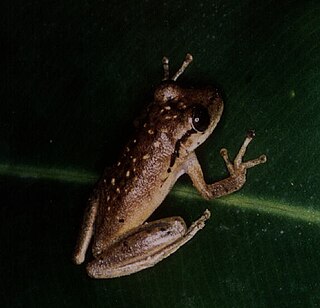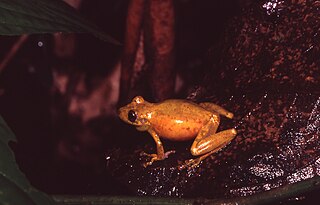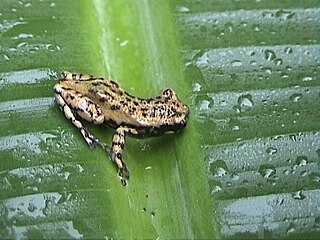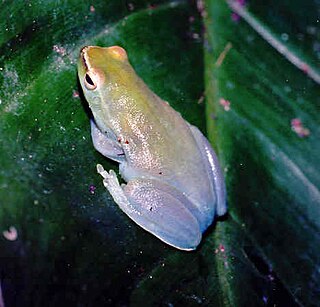
Scinax is a genus of frogs in the family Hylidae found in eastern and southern Mexico to Argentina and Uruguay, Trinidad and Tobago, and Saint Lucia. These are small to moderate-sized tree frogs, drably colored. Duellman and Wiens resurrected this genus in 1992. The name originates from the Greek word skinos, meaning quick or nimble.

Dendropsophus marmoratus is a species of frog in the family Hylidae. It is found in the Amazon rainforest and montane forests in the eastern piedmont, in Bolivia, Brazil, Colombia, Ecuador, French Guiana, Guyana, Peru, Suriname, and Venezuela. Its natural habitats are subtropical or tropical moist lowland forests, intermittent freshwater marshes, and heavily degraded former forest. "Marmoratus" in Latin means "marble," perhaps referring to the dorsal coloring pattern. It is threatened by habitat loss.

Dendropsophus microcephalus is a species of frog in the family Hylidae. It is found in southeastern Mexico, Central America, and northern South America in Colombia, Venezuela, Trinidad and Tobago, the Guianas, and northern Brazil. This widespread species might actually be a species complex. Its common names include yellow treefrog, small-headed treefrog, and yellow cricket treefrog.

Osteocephalus buckleyi, also known as Buckley's slender-legged treefrog, is a species of frog in the family Hylidae. It is found along the periphery of the Amazon Basin in Bolivia, Peru, Ecuador, Colombia, northeastern Brazil, Venezuela, Guyana, Suriname, and French Guiana, and also in the Orinoco Delta in Venezuela. It is probably a species complex. Some sources treat Osteocephalus vilmae from Ecuador and Peru as a valid species.
Osteocephalus deridens is a species of frog in the family Hylidae. It is found in the Napo and Pastaza River drainages in eastern Ecuador and in the Loreto Region, northern Peru. The specific name deridens is derived from Latin deridere, meaning "make fun of someone". This alludes to the males calling from the treetops that sound "as if they are laughing at the collectors' vain attempts to reach them". Common name funny slender-legged treefrog has been coined for this species.
Osteocephalus fuscifacies is a species of frog in the family Hylidae endemic to Ecuador. It is known from the Napo River drainage at intermediate elevations. The specific name fuscifacies is derived from Latin fuscus (=tan) and facies (=face), in reference to the uniform tan-colored loreal region and the lack of a light subocular spot. Common name Napo slender-legged treefrog has been coined for this species.

Scinax boesemani is a species of frog in the family Hylidae. It is found in The Guianas, southern Venezuela (Amazonas), and northern Brazil. The specific name boesemani honors Marinus Boeseman, a Dutch ichthyologist. Common name Boeseman's snouted treefrog has been coined for it.

Scinax boulengeri is a species of frog in the family Hylidae. It is found in Colombia, Costa Rica, Nicaragua, Panama, and possibly Honduras. Its natural habitats are subtropical or tropical moist lowland forests, intermittent freshwater marshes, pastureland, plantations, rural gardens, and urban areas. It has been found as high as 600 meters above sea level.

Scinax cruentomma is a species of frog in the family Hylidae. It is found in the upper Amazon Basin of southern Colombia, eastern Ecuador, northeastern and east-central Peru, and western Brazil; its presence is French Guiana is dispted. The specific name cruentomma is derived from the Greek cruentos meaning "bloody" and omma meaning "eye", referring to the red streak in the eye of this frog. This species is also known as the Manaus snouted treefrog.
Scinax danae is a species of frog in the family Hylidae. It is endemic to southeastern Venezuela and occurs in the La Escalera region of the Sierra de Lema, Bolívar state. The specific name danae honors Dana Trueb Duellman, the daughter William E. Duellman, the scientist who described this species. Despite this, common name Bolivar snouted treefrog has been coined for this species.

Scinax elaeochroa, commonly known as the Sipurio snouted treefrog, or olive snouted treefrog, is a species of frog in the family Hylidae. It is found in the Caribbean lowlands of Nicaragua and Panama and in the Pacific lowlands of Costa Rica and Panama, with an isolated population in Colombia.
Scinax exiguus is a species of frog in the family Hylidae. It is found in the Gran Sabana of Venezuela and in the Roraima state of the adjacent northern Brazil, as far south as Boa Vista, Roraima. Common name Gran Sabana snouted treefrog has been coined for it.

Scinax rostratus is a species of frog in the family Hylidae. It is found in central Panama and eastward to Colombia, Venezuela, and coastal lowlands of Guyana, Suriname, and French Guiana. Common name Caracas snouted treefrog has been coined for this species.

Scinax x-signatus is a species of frog in the family Hylidae. It is found in Brazil, the Guyanas, Venezuela and Colombia. Introduced populations exist on Guadeloupe and two nearby smaller islands, Marie Galante and La Désirade, and on Martinique. It may represent more than one species.

Sphaenorhynchus dorisae, the Doris' lime treefrog, is a species of frog in the family Hylidae. It is found in the upper Amazon Basin of southeastern Colombia, Ecuador, Brazil and Peru. It might also be present in Bolivia.

Sphaenorhynchus lacteus, the Orinoco lime treefrog or greater hatchet-faced treefrog, is a species of frog in the family Hylidae. It is a widely distributed species found in the Orinoco and Amazon basins in Venezuela, the Guianas, Colombia, Brazil, Ecuador, Peru, and Bolivia. It also occurs in Trinidad and Tobago.
Pristimantis pseudoacuminatus, also known as Sarayacu robber frog, is a species of frog in the family Strabomantidae. It is found in the Amazon basin in Colombia, Ecuador, and Peru.

Hamptophryne boliviana, also known as the Bolivian bleating frog or Amazon sheep frog, is a species of frogs in the family Microhylidae. It is found in the northern and western sides of the Amazon basin in Bolivia, Brazil, Colombia, Ecuador, French Guiana, Guyana, Peru, Suriname, and Venezuela. Genetic analysis suggests hidden diversity within the nominal species.

Dendropsophini is a tribe of small neotropical tree frogs in the subfamily Hylinae. They are distributed from southern Mexico, throughout Central America, and down South America to northern Argentina and Uruguay. Removed from the synonymy of Hylinae in 2016, this taxon was formerly considered its own subfamily before being reclassified as a tribe. As defined by Favovich et al. in 2005, the tribe Dendrosophini contains the members of three former subfamilies within the Hylidae prior to taxonomic rearrangement: Dendropsophinae, Pseudinae, and Scinaxinae.
Scinax ruberoculatus, the red-eyed snouted tree frog, is a frog in the family Hylidae. It is endemic to forest habitats in Brazil, Suriname, and French Guiana.















